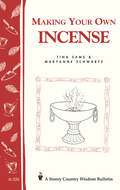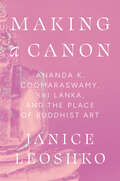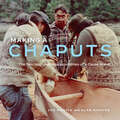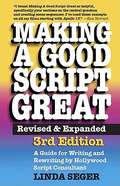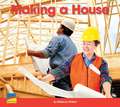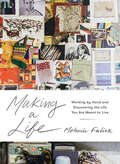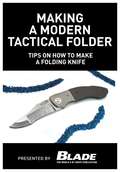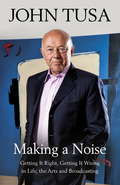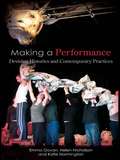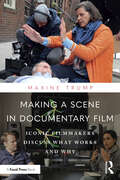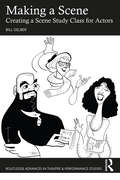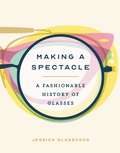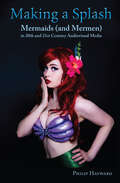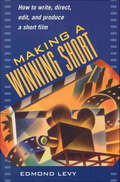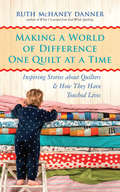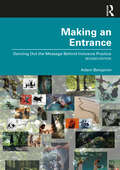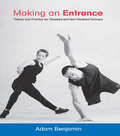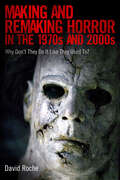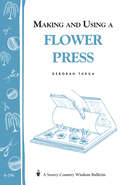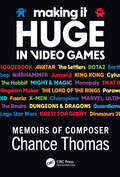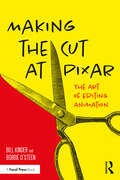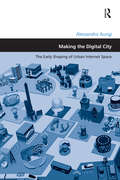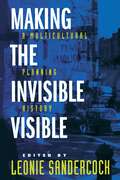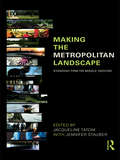- Table View
- List View
Making Your Own Incense: Storey Country Wisdom Bulletin A-226 (Storey Country Wisdom Bulletin Ser.)
by Tina Sams Maryanne SchwartzSince 1973, Storey's Country Wisdom Bulletins have offered practical, hands-on instructions designed to help readers master dozens of country living skills quickly and easily. <P><P>There are now more than 170 titles in this series, and their remarkable popularity reflects the common desire of country and city dwellers alike to cultivate personal independence in everyday life.
Making a Canon: Ananda K. Coomaraswamy, Sri Lanka, and the Place of Buddhist Art (Buddhism and Modernity)
by Janice LeoshkoThe story of how one scholar’s experiences in Sri Lanka shaped the contours of the Buddhist visual canon. An early interpreter of Buddhist art to the West, Ananda Kentish Coomaraswamy laid the foundation of what would become the South Asian visual canon, particularly through his efforts to understand how Buddhist art emerged and developed. In Making a Canon, Janice Leoshko examines how Coomaraswamy’s experience as the director of a mineralogical survey in Sri Lanka shaped his understanding of South Asian art and religion. Along the way, she reveals how Coomaraswamy’s distinctive repetition of Sri Lankan visual images in his work influenced the direction of South Asia’s canon formation and left a lasting impression on our understanding of Buddhist art.
Making a Chaputs: The Teachings and Responsibilities of a Canoe Maker
by Joe Martin Alan HooverA rich visual testament to the practical and cultural power of the dugout canoe, balanced in its description of meaning and method.Tla-o-qui-aht master canoe maker Joe Martin, in collaboration with former museum curator Alan Hoover, describes the meaning and method behind one of the most vivid and memorable symbols of the Northwest Coast: the dugout canoe. Both artform and technological marvel, the chaputs carries Indigenous cultural knowledge passed down through generations, not only of the practical forestry and woodworking that shape every canoe, but also of the role and responsibilities of the canoe maker.The text includes both a step-by-step explanation of the canoe-making process from tree selection onward (carefully described and dynamically illustrated) and the personal histories of a number of Joe's canoes, encompassing their planning, creation, cultural significance and role in the process of reconciliation. The teachings Joe received from his father and the expertise he has gained in a lifetim of canoe-making are recorded here in his own words for generations to come.
Making a Good Script Great (3rd edition)
by Linda SegerThis book takes you through the whole screenwriting process--from initial concept through final rewrite--providing specific methods that will help you craft tighter, stronger, and more saleable scripts.
Making a House
by Rebecca WeberThis book is about the types and purposes of tools that are used to build houses.
Making a Life: Working by Hand and Discovering the Life You Are Meant to Live
by Melanie Falick&“Falick&’s treasury, sumptuously photographed, will appeal to anyone who admires the people dedicated to making the world around them more beautiful.&” —Publishers Weekly, starred reviewWhy do we make things by hand? And why do we make them beautiful? Led by the question of why working with our hands remains vital and valuable in the modern world, author and maker Melanie Falick went on a transformative, inspiring journey. Traveling across continents, she met quilters and potters, weavers and painters, metalsmiths, printmakers, woodworkers, and more, and uncovered truths that have been speaking to us for millennia yet feel urgently relevant today: We make in order to slow down. To connect with others. To express ideas and emotions, feel competent, create something tangible and long-lasting. And to feed the soul. In revealing stories and gorgeous original photographs, Making a Life captures all the joy of making and the power it has to give our lives authenticity and meaning.
Making a Modern Tactical Folder: Tips on How to Make a Folding Knife
by Joe KertzmanThere are many ways to make a knife, so Allen Elishewitz gives step-by-step instructions on building his style of high-tech folders that can be followed using simple or large industrial-type machines.
Making a Noise: Getting It Right, Getting It Wrong In Life, Arts And Broadcasting
by John TusaIn almost sixty years of professional life, John Tusa has fought for and sometimes against the major arts and political institutions in the country. A distinguished journalist, broadcaster and leader of arts organisations, he has stood up publicly for the independence of the BBC, the need for public funding of the arts and for the integrity of universities. He has made enemies in the process. From the battles to create the ground-breaking Newsnight in 1979, to six years of defending the BBC World Service from political interference, Tusa's account is etched with candour. His account of two years of internecine warfare at the top of the BBC under the Chairman, 'Dukey' Hussey will go down as a major contribution to BBC history. His recollections of a hilarious and petty-minded few months as head of a Cambridge college will be read as a case study of the absurdities of academic life; while running the rejected and maligned Barbican Centre, Tusa led its recovery into the major cultural centre that it is today.Often based on personal diaries, Making a Noise is a fearless and entertaining memoir of life at the top of the arts and broadcasting.
Making a Noise: Getting It Right, Getting It Wrong in Life, Arts and Broadcasting
by Sir John TusaJohn Tusa is a distinguished journalist, broadcaster and leader of arts organisations, best remembered for his times at the BBC, including creating Newsnight.Tusa's memoir is etched with candour. His account of two years of internecine warfare at the top of the BBC under the Chairman, 'Dukey' Hussey will go down as a major contribution to BBC history. His recollections of a hilarious and petty-minded few months as head of a Cambridge college will be read as a case study of the absurdities of academic life; while running the rejected and maligned Barbican Centre, Tusa led its recovery into the major cultural centre that it is today.
Making a Performance: Devising Histories and Contemporary Practices
by Katie Normington Helen Nicholson Emma GovanMaking a Performance traces innovations in devised performance from early theatrical experiments in the twentieth-century to the radical performances of the twenty-first century. This introduction to the theory, history and practice of devised performance explores how performance-makers have built on the experimental aesthetic traditions of the past. It looks to companies as diverse as Australia's Legs on the Wall, Britain's Forced Entertainment and the USA-based Goat Island to show how contemporary practitioners challenge orthodoxies to develop new theatrical languages. Designed to be accessible to both scholars and practitioners, this study offers clear, practical examples of concepts and ideas that have shaped some of the most vibrant and experimental practices in contemporary performance.
Making a Scene in Documentary Film: Iconic Filmmakers Discuss What Works and Why
by Maxine TrumpThis collection of iconic interviews helps demystify the documentary filmmaking process by deconstructing the most relevant and important scenes in some of today's most well-known documentary films. It offers concrete, real-world examples of the situations and decisions that filmmakers navigate. We go behind the scenes with the creators to learn the methodologies and approaches these directors, cinematographers, editors, and sound recordists have taken to bring these amazing documentaries to life. What makes a great scene? Why are they so important in the construction of a great film? The interviews included offer excellent insights from the directors of the award-winning The Truffle Hunters, My Octopus Teacher, Collective, Knock Down the House, Dick Johnson Is Dead, and Trapped; the cinematographer of RBG, Julia, and Fauci; the editor of Time; and sound recordist of Tiger King. Award-winning documentary filmmaker and esteemed Sundance advisor Maxine Trump goes in-depth with each filmmaker, asking about their creative process. Why did these scenes make such a deep impression on both the filmmakers and their audience? Was it the cinematic style, the dynamic dialogue, the magic of observational filmmaking, or a surprising turning point? This technical but creative and accessible resource is suitable for documentary filmmakers, aspiring directors, producers, editors, and cinematographers of non-fiction film. Each interview offers a fresh perspective to the emerging or professional filmmaker and audience alike.
Making a Scene: Creating a Scene Study Class for Actors (ISSN)
by Bill GelberBased on the author’s decades of teaching, pedagogical and theatrical research, and his professional experience as actor and director, Making a Scene: Creating a Scene Study Class for Actors offers a pedagogical approach to rehearsal scenes as a primary tool for diagnosis and actor improvement.This volume carefully lays out the case for thinking deeply and critically about the nature of every facet of an acting class: the environment of the classroom, the choice of material for performing, diagnostic tools for responding to scene sessions, and means for engaging all students. This study includes suggestions for a teacher’s philosophy towards the work; a justification for implementing games, improvisations, and etudes; suggestions for resources for exercises both basic and complex; and a brief discussion on approaches to period styles material and connecting it to contemporary student life and issues.Addressed to both the beginning theatre teacher and the seasoned educator, this will be an essential book for anyone seeking to update their work with performers in private studios, high school settings, or in higher education.
Making a Spectacle: A Fashionable History of Glasses
by Jessica GlasscockFrom 13th century Franciscan monks to Beyoncé in Black is King, Making a Spectacle charts the fascinating ascension of eyeglasses—from an unsightly but useful tool to fashion's must-have accessory.The power of glasses to convey a range of vivid messages about their wearers have made them into a billion-dollar business that appeals to cool kids and rock stars, and those who want to be like them, but the fashionable history of eyeglasses is fraught with anxiety and drama. At the beginning of the 20th century, the assessment in Vogue and Harper's Bazaar was that spectacles were "invariably disfiguring." Invisibility was the best option, and glasses were only to be put on once the lights at the opera went dark.While variations of that glasses-shaming sentiment appeared at regular intervals over the next 100 years or so, eyeglasses continued to evolve into an endless array of shapes, colors, purposes, and personalities. Once sunglasses took off in the 1930s, the magazine editorial made glasses a conspicuous part of the fashion narrative. Eyeglasses went to the ski slopes, the stables, the beach, the Havana hotel. Plastic innovations made a candy-colored rainbow of cat-eyes and "starlet" styles possible. Suddenly, everyone had the opportunity to look like Jackie O on vacation in Capri.Making a Spectacle traces contemporary high fashion frames back to their origins: the military aviator, the glam cat eye, the nerdly Oxford, the high-tech shield, the fanciful butterfly, the lowly rimless, and other styles all make an appearance. Featuring interviews with influential designers, makers, and purveyors of glasses including Adam Selman, Kerin Rose Gold, and l.a. Eyeworks, Making a Spectacle also takes a look at today's most cutting edge eyewear, showing the reader the latest and most innovative ways to see and be seen.
Making a Splash: Mermaids (and Mermen) in 20th and 21st Century Audiovisual Media
by Philip HaywardThe representation of aquatic people in contemporary film and television—from their on-screen sexuality to the mockumentaries they’ve inspired.Mermaids have been a feature of western cinema since its inception and the number of films, television series, and videos representing them has expanded exponentially since the 1980s. Making a Splash analyses texts produced within a variety of audiovisual genres. Following an overview of mermaids in western culture that draws on a range of disciplines including media studies, psychoanalysis, and post-structuralism, individual chapters provide case studies of particular engagements with the folkloric figure. From Hans Christian Andersen’s “The Little Mermaid” to the creation of Ursula, Ariel’s tentacled antagonist in Disney’s 1989 film, to aspects of mermaid vocality, physicality, agency, and sexuality in films and even representations of mermen, this work provides a definitive overview of the significance of these ancient mythical figures in 110 years of western audio-visual media.
Making a Winning Short: How to Write, Direct, Edit, and Produce a Short Film
by Edmond LevyMaking a Winning Short is the first book to give hands-on instruction on how to write, direct, edit, and produce a fictional short in film or video. Edmond Levy guides the beginning filmmaker step-by-step through the stages of making a short: writing the script (from developing the idea to fine-tuning the final draft), launching production, casting, and working with the actors, working with the crew, directing the camera, editing, and other aspects of post-production. He devotes a separate chapter to Hi-8 video and gives a list of short-film festivals, both domestic and international.
Making a World of Difference One Quilt at a Time
by Ruth Mchaney DannerQuilts exemplify precious things: comfort through the warmth they provide; community, since they are often created by groups; and love, given the time and effort they require. With this in mind, legions of kindhearted quilters all over the world choose to donate their labors of love to people in need. Ruth McHaney Danner has gathered fifty-four heartwarming stories of quilters who make their compassion tangible one stitch, square, and quilt at a time. Each story introduces a quilter or group of quilters, ranging from a blind woman in Texas to preschoolers in Australia. Their gifts have the power to make recipients feel cherished and supported, even though they may never meet face-to-face. These wonderfully inspiring stories show that every quilter who has ever wondered, "But what can I do?" can do something to reach out and help others.
Making an Entrance: Dancing Out the Message Behind Inclusive Practice
by Adam BenjaminThis second edition of Making an Entrance is a practical and thought-provoking introduction to teaching dance with disabled and non-disabled students, updated with expanded coverage, new and revised exercises, and chapters that cover post-pandemic and online practice, diversity and inclusivity. With improvisation as his central concern Benjamin covers an extensive range of topics, including new autoethnographic writing, mental health, performance, feedback, and The Dancers’ Forest, and interrogates what we mean when we talk about ‘inclusive’ and ‘integrated dance.’ There are over 50 stimulating and challenging exercises purposefully designed for dance students of all levels accompanied by teaching notes, and examples drawn from the author’s experience as a teacher, performer, and dance maker. Useful hints are provided on the practicalities of setting up workshops covering issues such as class sizes, the safety aspects of wheelchairs and accessibility. An essential read for both students and teachers of improvisation who are seeking ways to engage with issues of diversity, written to be accessible whilst offering areas of increasing complexity and challenge for more experienced practitioners.
Making an Entrance: Theory and Practice for Disabled and Non-Disabled Dancers
by Adam BenjaminMaking an Entrance is the first ever practical introduction to teaching dance with disabled and non disabled students. This clearly written, thought provoking and hugely enjoyable manual is essential reading whether you're just starting out or are already active in the field.Taking improvisation as his focus and as the starting point of choreographic exploration, Adam Benjamin asks what it has to offer as an art form and how it can be better used to meet the changing needs of dance education.In the theoretical section Benjamin explores the history of a disintegrated dance practice, placing it within the wider context of cultural and political movements. He questions what is meant today when we talk about 'inclusive' or 'integrated dance' and what we might expect of it.The book includes over 50 exercises and improvisations designed to stimulate and challenge students at all levels of dance. Benjamin also includes useful hints on the practicalities of setting up workshops covering issues as diverse a class size, the safety aspects of wheelchairs and the accessibility of dance spaces.
Making and Remaking Horror in the 1970s and 2000s: Why Don't They Do It Like They Used To?
by David RocheIn Making and Remaking Horror in the 1970s and 2000s author David Roche takes up the assumption shared by many fans and scholars that original horror movies are more “disturbing,” and thus better than the remakes. He assesses the qualities of movies, old and recast, according to criteria that include subtext, originality, and cohesion. With a methodology that combines a formalist and cultural studies approach, Roche sifts aspects of the American horror movie that have been widely addressed (class, the patriarchal family, gender, and the opposition between terror and horror) and those that have been somewhat neglected (race, the Gothic, style, and verisimilitude). Containing seventy-eight black-and-white illustrations, the book is grounded in a close comparative analysis of the politics and aesthetics of four of the most significant independent American horror movies of the 1970s—The Texas Chain Saw Massacre, The Hills Have Eyes, Dawn of the Dead, and Halloween—and their twenty-first-century remakes. To what extent can the politics of these films be described as “disturbing” insomuch as they promote subversive subtexts that undermine essentialist perspectives? Do the politics of the film lie on the surface or are they wedded to the film's aesthetics? Early in the book, Roche explores historical contexts, aspects of identity (race, ethnicity, and class), and the structuring role played by the motif of the American nuclear family. He then asks to what extent these films disrupt genre expectations and attempt to provoke emotions of dread, terror, and horror through their representations of the monstrous and the formal strategies employed? In this inquiry, he examines definitions of the genre and its metafictional nature. Roche ends with a meditation on the extent to which the technical limitations of the horror films of the 1970s actually contribute to this “disturbing” quality. Moving far beyond the genre itself, Making and Remaking Horror studies the redux as a form of adaptation and enables a more complete discussion of the evolution of horror in contemporary American cinema.
Making and Using a Flower Press: Storey's Country Wisdom Bulletin A-196
by Deborah TukuaSince 1973, Storey's Country Wisdom Bulletins have offered practical, hands-on instructions designed to help readers master dozens of country living skills quickly and easily. There are now more than 170 titles in this series, and their remarkable popularity reflects the common desire of country and city dwellers alike to cultivate personal independence in everyday life.
Making it HUGE in Video Games: Memoirs of Composer Chance Thomas
by Chance ThomasMaking it HUGE in Video Games recounts the astonishing journey of an unassuming, middle-of-the-bell-curve young man, rising from mundane beginnings to scale the dizzying heights of artistic distinction and financial success in the worldwide video game industry.This is the story of Chance Thomas, a moderately talented musician who struggled and grew to compose original scores for some of the most well-known entertainment properties in the world. Detailed personal accounts and instructive side bars carry readers across the jagged peaks and valleys of an absolutely achievable career in video games. World-famous IP’s get personal treatment here – The Lord of the Rings, Marvel, Avatar, Dungeons & Dragons, Warhammer, DOTA 2, King Kong, The Settlers, and many more.Readers will discover unvarnished true stories about starting out, pitching and pursuing gigs, negotiating contracts, composing and producing scores, multinational corporations and personalities, funny anecdotes, daunting challenges, glorious successes, and instructive failures. Autobiographical details throughout provide intimate perspective, vibrant color, and inspiration. The book is written in a comfortable, conversational style.Think of this as a career guidebook wrapped around a personal retrospective; a professional how-to manual woven into a memoir.
Making the Cut at Pixar: The Art of Editing Animation
by Bill Kinder Bobbie O'SteenJoin industry insiders Bill Kinder and Bobbie O’Steen as they guide readers on a journey through every stage of production on an animated film, from storyboards to virtual cameras and final animation. With unprecedented access to the Pixar edit suite, this authoritative project highlights the central role film editors play in some of the most critically acclaimed and commercially successful movies of all time. Exclusive interviews with animation editors and other creative leads are supported by footage from deep inside Pixar’s vault. Nearly 90 minutes of video segments include never-before-seen works in progress, deleted scenes, and demonstrations to shed light on how these beloved stories are crafted. The challenges and essential contributions of editors in animation have never been examined in such depth and detail. In addition to exploring method and craft, this book provides important context for the editor in animation history, the evolution of technology, and Pixar’s uniquely collaborative studio culture. A must-read for students of digital filmmaking, filmmakers in all aspects of production, and fans of Pixar movies.
Making the Digital City: The Early Shaping of Urban Internet Space (Design and the Built Environment)
by Alessandro AurigiSince the late 1990s, Information and Communication Technologies (ICTs) have been hailed as a potentially revolutionary feature of the planning and management of Western cities. Economic regeneration and place promotion strategies have exploited these new technologies; city management has experimented with electronically distributed services, and participation in public life and democratic decision-making processes can be made more flexible by the use of ICTs. All of these technological initiatives have often been presented and accessed via an urban front-end information site known as 'digital city' or 'city network.' Illustrated by a range of European case studies, this volume examines the social, political and management issues and potential problems in the establishment of an electronic layer of information and services in cities. The book provides a better understanding of the direction European cities are going towards in the implementation of ICTs in the urban arena.
Making the Invisible Visible: A Multicultural Planning History (California Studies in Critical Human Geography #2)
by Leonie SandercockThe history of planning is much more, according to these authors, than the recorded progress of planning as a discipline and a profession. These essays counter the mainstream narrative of rational, scientific development with alternative histories that reveal hitherto invisible planning practices and agendas. While the official story of planning celebrates the state and its traditions of city building and regional development, these stories focus on previously unacknowledged actors and the noir side of planning.Through a variety of critical lenses—feminist, postmodern, and postcolonial—the essays examine a broad range of histories relevant to the preservation and planning professions. Some contributors uncover indigenous planning traditions that have been erased from the record: African American and Native American traditions, for example. Other contributors explore new themes: themes of gendered spaces and racist practices, of planning as an ordering tool, a kind of spatial police, of "bodies, cities, and social order" (influenced by Foucault, Lefebvre, and others), and of resistance.This scrutiny of the class, race, gender, ethnic, or ideological biases of ideas and practices inherent in the notion of planning as a modernist social technology clearly points to the inadequacy of modernist planning histories. Making the Invisible Visible redefines planning as the regulation of the physicality, sociality, and spatiality of the city. Its histories provide the foundation of a new, alternative planning paradigm for the multicultural cities of the future.
Making the Metropolitan Landscape: Standing Firm on Middle Ground
by Jacqueline Tatom Jennifer StauberThe American landscape is an extremely complex terrain born from a history of collective and individual experiences. These created environments, which all may be called metropolitan landscapes, constantly challenge students and professionals in the fields of architecture, design and planning to consider new ways of making lively public places. This book brings together varied voices in urban design theory and practice to explore new ways of understanding place and our position in it.
